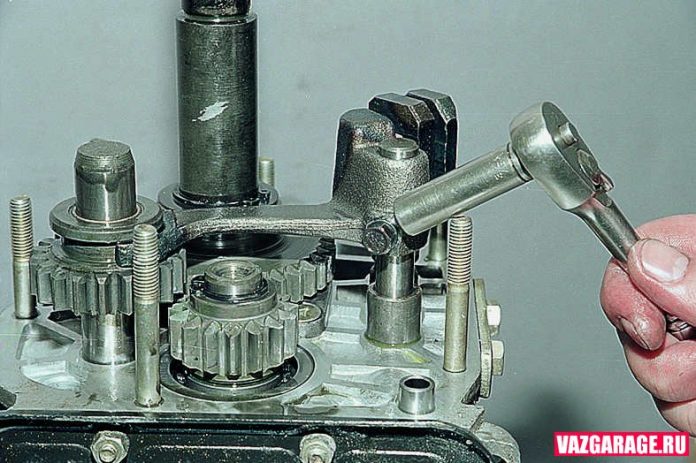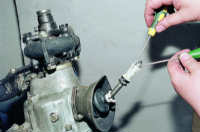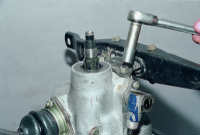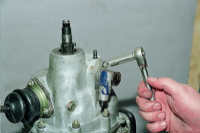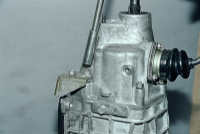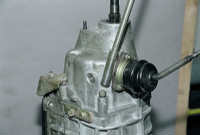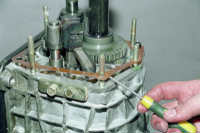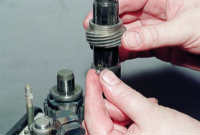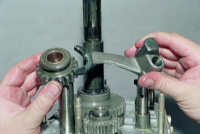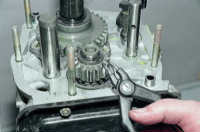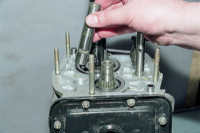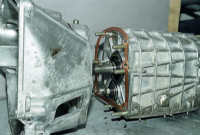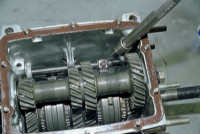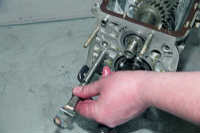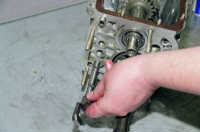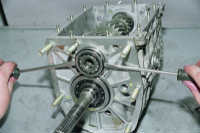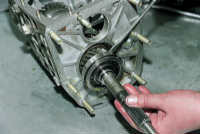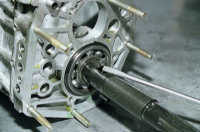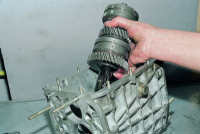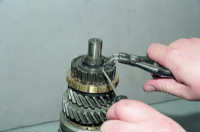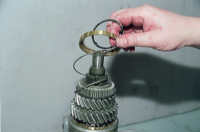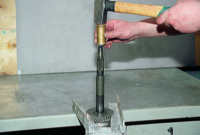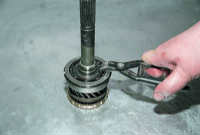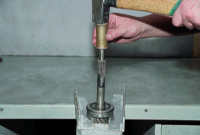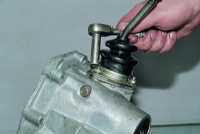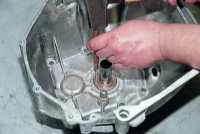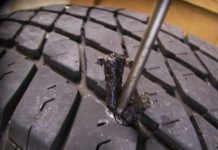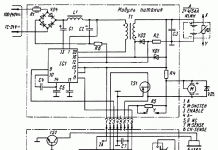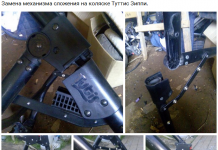In detail: vaz 2106 box do-it-yourself repair from a real master for the site my.housecope.com.
To complete the work, you will need fixing glue, an impact screwdriver, oil seals for the primary and secondary shafts, a set of gaskets, and a torque wrench.
1. Drain the oil from the gearbox (see “Gearbox - Checking the Oil Level and Changing the Oil”).
2. Remove the gearbox (see "Gearbox - removal and installation").
3. We clean with a brush and rinse the outer surface of the box with kerosene or white spirit.
4. Remove the release bearing clutch and the clutch release fork from the gearbox (see "Clutch parts - removal and installation").
5. Disconnect the flexible coupling of the propeller shaft from the flange on the output shaft of the box (see "Propeller drive - disassembly and assembly").
6. Remove the flange of the flexible coupling from the output shaft of the gearbox (see "Output shaft oil seal - replacement").
7. Disconnect the support of the power unit with a cross member from the rear cover of the gearbox (see “Power unit mounts - replacement”).
8. Remove the speedometer drive (see “Speedometer drive - replacement”).
9. Remove the reversing light switch (see “Reversing light switch - check and replacement”).
10. Remove the cuff from the ball joint of the gear lever.
11. Key by 10 mm unscrew the three nuts securing the gear lever housing to the rear crankcase cover.
12. Remove the lever housing and the sealing gasket from the studs A under him.
13. Socket wrench by 13 mm we unscrew the two nuts securing the bracket for the exhaust pipe of the exhaust system.
14. Remove the bracket and take out the square head bolt underneath.
| Video (click to play). |
15. Socket and box wrenches by 13 mm unscrew the five nuts securing the back cover.
16. Socket wrench by 10 mm unscrew ten nuts securing the bottom cover.
17. Remove the cover and the gasket underneath.
18. Some nuts will come loose with the studs. In this case, after washing the threaded holes and studs with a solvent, apply fixing glue according to the instructions and install the studs in place.
19. Key by 13 mm unscrew the remaining rear cover retaining nut located inside the crankcase.
20. To facilitate the removal of the rear cover, use a screwdriver to recess the 1st and 2nd gear engagement rod. This engages second gear.
21. Tapping the cover with a hammer with a rubber or wooden striker along the perimeter of the mounting plane, disconnect it from the box crankcase.
22. Remove the rear cover from the studs, and then, turning it clockwise, remove it from the crankcase. A gasket between the cover and the crankcase could break. When assembling, we install a new gasket.
23. We remove from the back cover the plastic plug of the block of gears of the 5th and reverse gears, squeezing it out with a suitable tool through the hole in the bearing.
24. Using pliers, remove the thrust ring of the bearing of the V-th gear block and reverse gear from the groove in the cover.
25. In order not to damage the rear cover, install it on two wooden blocks and press out the bearing of the gear block of the V-th gear and reverse gear with a hammer (through a mandrel of a suitable diameter). The inner ring of the bearing usually remains on the block shaft.
27. Remove the secondary shaft oil seal from the hole in the rear cover (see "Output shaft oil seal - replacement").
28. Take out the thrust washer of the inner ring of the rear bearing of the secondary shaft.
29. Press out the rear bearing of the output shaft with a mandrel suitable for the diameter and take it out.
30. Remove the inner ring of the rear bearing from the secondary shaft.
We assemble the bearing by tying its parts with wire or twine.
31.We remove the gear wheel of the speedometer drive and the ball - retainer A gears located in the groove of the shaft.
32. Remove the slinger washer.
33. The key by 10 mm unscrew the bolt securing the V-th gear and reverse gear.
34. To block the rotation of the shafts, we shift the intermediate gear A reverse, including reverse gear. The second gear was engaged earlier when removing the rear cover. If it turns off, press the stock B... Socket wrench by 17 mm we loosen the tightening of the bolt securing the block of gears of the 5th gear and reverse gear, without completely unscrewing the bolt.
35. Socket wrench by 13 mm unscrew one nut securing the clutch housing to the gearbox and a socket wrench by 17 mm unscrew the remaining six nuts.
36. Having wrung out with a screwdriver, disconnect the clutch housing from the box and remove the gasket.
37. To replace the input shaft oil seal, press it out with a punch through the hole in the flange of the front cover of the gearbox.
38. Using the pliers, remove the oil seal from the front cover of the gearbox.
39. Remove the spring ring from the input shaft of the gearbox. The ring has a tapered shape and is installed with a smaller diameter towards the bearing.
40. Socket wrench by 19 mm we unscrew the bolt securing the front bearing of the intermediate shaft and take out the bolt together with the spring and clamping washers.
41. Socket wrench by 17 mm finally unscrew and remove the bolt securing the gear block.
42. Moving the V-th gear shift fork along the rod, remove the gear block from the intermediate shaft.
43. Install the gear block in a vice and press the inner ring of the intermediate shaft rear bearing with two large screwdrivers.
We assemble the bearing and tie its parts with wire or twine.
44. Remove the spacer washer from the secondary shaft.
45. Socket wrench by 13 mm we unscrew the two bolts securing the cover of the rod retainers.
46. Remove the cover with the gasket.
47. From the holes in the crankcase, remove the springs of the rod retainers. Spring A the locking rod for engaging the V-th gear and reverse gear differs from others in rigidity. To distinguish it, it has a dark color and during assembly it must be installed in its place.
48. It is more convenient to remove the retaining balls with a rubber bulb, creating a vacuum.
49. Remove the V-th gear gear assembly with a synchronizer from the secondary shaft.
50. Remove the spacer ring.
51. Having moved the gear selection fork, remove the V-gear synchronizer sleeve.
52. Holding the fork, remove the intermediate reverse gear from the axle.
53. Remove the rod of inclusion of the V-th gear and reverse gear together with the shift fork and the remote bushing A stock. Remove the bushing and plug from the stem.
54. Socket wrench by 10 mm unscrew the bolt securing the stem head and remove it.
55. Using a magnetic screwdriver or using a rubber bulb, remove from the hole A in the crankcase wall a blocking cracker.
56. Using pliers, unclench the V-gear synchronizer hub retaining ring and remove it.
57. Remove the hub from the shaft.
58. Remove the spring washer.
59. Remove the reverse gear.
60. Having pushed out from the inside, we take out the rear bearing of the intermediate shaft.
61. Prying on the locating ring with two screwdrivers, take out the front bearing of the intermediate shaft.
62. We take out the intermediate shaft from the crankcase.
63. Prying with two screwdrivers, remove a part of the inner ring of the rear bearing from the intermediate shaft and assemble the bearing.
64. Socket wrench by 10 mm with an extension cord, unscrew the bolt securing the 3rd and 4th gear shift fork to the rod.
65. We take out the engagement rod of the III and IV gears from the hole, at the same time removing the plug from it.
66. From the hole in the rod, remove the blocking cracker.
67. With a powerful magnet or with the help of a rubber bulb, we extract the blocking cracker from the hole in the crankcase.
68. Socket wrench by 10 mm unscrew the bolt fastening the forks of the 1st and 2nd gears.
69. We take out the stem from the hole, at the same time removing the plug from it.
70. Using an impact screwdriver, unscrew the three screws securing the retaining plate of the intermediate bearing of the secondary shaft and remove it.
71. Prying with two large screwdrivers for the bearing mounting ring, we push the bearing out of the crankcase.
72. Remove the input shaft assembly.
73. Take out the front roller bearing from the shaft bore. The bearing can also remain at the end of the output shaft.
74. Prying with two screwdrivers on the locating ring of the intermediate bearing of the secondary shaft, we pull the bearing off the shaft.
75. We take out the secondary shaft from the crankcase.
76. Holding with a key by 24 mm axle of the intermediate gear wheel of reverse gear from turning, with a socket wrench by 19 mm unscrew the axle nut.
77. Clamping the secondary shaft vertically in a vice through soft pads, remove the synchronization clutch of the III and IV gears from the shaft.
78. Using pliers, unclench and remove the hub retaining ring from the shaft.
79. Remove the spring washer.
80. Remove the synchronization clutch hub.
81. We remove the gear wheel with the synchronizer of the III-rd transfer.
82. We support the edges of the 1st gear gear on a rigid base (for example, two keys), up to 5 mm thick. We press out the secondary shaft from the gear sleeve through a drift from soft metal.
84. Remove the gear with the 1st gear synchronizer.
85. We take out the hub of the synchronization clutch of the 1st and 2nd gears.
86. Remove the synchronization clutch.
87. Remove the gear with a synchronizer of the 2nd gear from the shaft.
88. Having fastened the input shaft in a vice through soft lining, we push apart and remove the bearing retaining ring with pliers.
89. Remove the spring washer.
90. Leaning the edges of the bearing on a rigid base, press out the input shaft from the inner ring of the bearing through a drift made of soft metal.
91. Holding the blocking ring of the synchronization clutch of the 4th gear by hand, use the pliers to push apart and remove the retaining ring.
92. Gradually releasing the locking ring, remove it and the synchronizer spring of the 4th gear.
93. Similarly, we analyze the mechanisms of synchronization of other transmissions.
The tightening torques of critical threaded connections of parts are given in the appendices (see “Tightening torques for threaded connections”).
Before assembly, we rinse all parts with white spirit or kerosene and blow with compressed air. We wash and blow through the bearings with compressed air. We inspect and replace worn parts. The parts should be free of damage and traces of excessive wear, and on the mating surfaces of the parts there should be no scuff marks.
The crankcase walls must be free of cracks, and the bearing seats must be free of signs of wear or damage. The contact surfaces of the connectors of the gearbox housing, clutch housing and rear cover must not be damaged, causing divergence of the shaft axes and insufficient tightness.
Damage or excessive wear of sliding surfaces and splines is not allowed on the shafts. Minor surface irregularities may be removed with fine-grained emery paper; if there are large damages or deformations, the shaft must be replaced with a new one.
The bearings should show no signs of destruction of the tracks, cages, balls or rollers; when the bearing rings are turned, the rolling should be smooth. When repairing gearboxes with a significant mileage (100 thousand km or more), it is advisable to replace all bearings with new ones, regardless of their current condition.
Excessive wear and chipping of gear teeth and synchronizers are not allowed, the working surface of the teeth must be smooth.
Also, deformation of the forks for engaging gears is not allowed, the rods of the forks must slide freely without a significant gap in the holes in the crankcase.
There should be no traces of binding on the hubs of the gear clutches.
The friction surfaces of the locking rings must be notched. In case of wear of the notch, replace the locking ring with a new one.
1. All gaskets and seals are replaced with new ones.
2.Before installation, the working surfaces of the oil seals are lubricated with a thin layer of grease.
3. When assembling the gearbox, lubricate all parts with gear oil.
4. When assembling the gear blocks on the shafts, installing the retaining rings, we seat them with a screwdriver until the rings are completely fixed.
5. When installing bearings on shafts, we apply force to the inner rings, and when installing in the holes of the crankcases, to the outer ones.
6. Press the input shaft oil seal into the front cover with a mandrel of a suitable diameter.
7. Further assembly of the transmission is carried out in reverse order. Before installing the box on the car, we check the clarity of the inclusion of all gears.
To disassemble and repair the VAZ 2106 gearbox, it is necessary to remove the gearbox from the car, for this we drain the gear oil from the gearbox, remove it from the car and remove the release bearing plug assembly with the bearing from it and follow the following instructions:
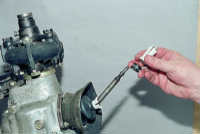
Use two screwdrivers to separate the sectors of the spacer sleeve and remove it and the rubber bushing of the damper
Remove the elastic coupling and flange from the output shaft of the gearbox
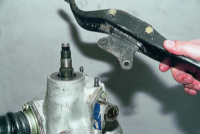
With a 13 head, unscrew the two support fastening nuts and remove it
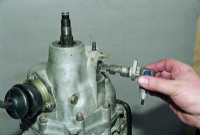 >
>
With a 10 head, we unscrew the fastening nut of the VAZ 2106 speedometer drive and remove the speedometer drive
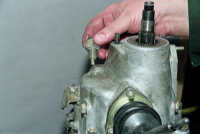
With a 22 key, turn off the VAZ 2106 reverse light switch and remove it
With a key 13, turn off the stop for moving the gear lever
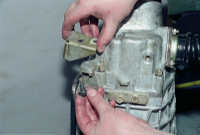
With a 13 head, we unscrew the two nuts securing the bracket, remove it and take out the square-head bolt
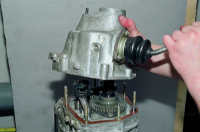
With a 13 head, unscrew the remaining nuts securing the rear cover of the gearbox and remove the rear cover by moving the shift lever to the right to free it from the gearshift rods
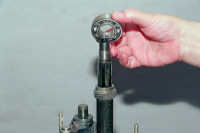
Carefully, trying not to damage, remove the rear cover gasket and remove the rear bearing
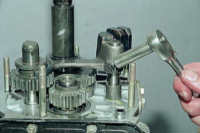
We remove the drive gear of the speedometer drive and its retainer - a steel ball and with a head of 10 unscrew the bolt securing the fork for engaging the reverse gear
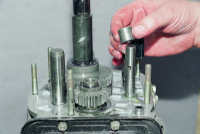
We remove the reverse gear fork and the reverse intermediate gear, then remove the distance sleeve from the reverse gear rod
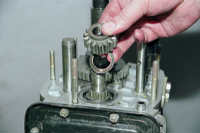
With a puller, remove the retaining ring from the intermediate shaft and remove the reverse drive gear and spring washer
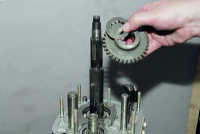
With a puller, remove the retaining ring from the secondary shaft, then remove the driven reverse gear and spring washer
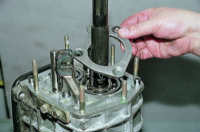
Using an impact screwdriver, unscrew the four screws securing the bearing locking plate and the axis of the intermediate reverse gear, remove it
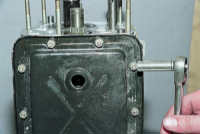
We take out the axis of the intermediate reverse gear and turn off the ten nuts securing the bottom cover with a 10 head
Remove the cover and put the gearbox on its side

Turn off one nut with a 13 head, and with a 17 head, six nuts securing the clutch housing to the gearbox
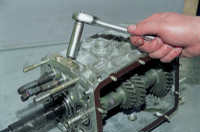
Disconnect the crankcases and remove the gasket and turn off the two bolts securing the cover of the rod retainers with a 13 head.

Remove the cover and remove three springs and three balls from the holes, then take out the backing fork rod
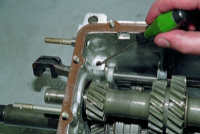
With a 10 head, unscrew the bolt securing the gear shift fork and take out the rods, while removing the locking crackers
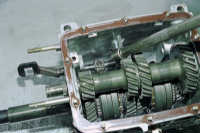
We take out the rod of the plug for engaging the first and second gears. With a 10 head, turn off the bolt securing the shift fork
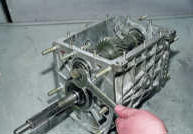
We take out the rod of the plug for engaging the third and fourth gears. By clicking on the couplings, we turn on two gears at once and with a 19 key turn off the bolt securing the front bearing of the intermediate shaft
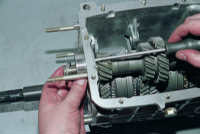
Prying the retaining ring with two screwdrivers, take out the front bearing of the intermediate shaft and push out the rear bearing of the intermediate shaft
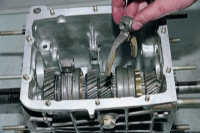
Having tilted, we take out the intermediate shaft of the VAZ 2106 from the gearbox housing, then we take out the two gear shift forks

Prying with a screwdriver, take out the primary shaft assembly of the VAZ 2106 with the bearing and the synchronizer ring and remove the needle bearing from the secondary shaft

Prying with a screwdriver, remove the key from the back of the secondary shaft.Prying off with two screwdrivers, remove the rear bearing of the secondary shaft VAZ 2106
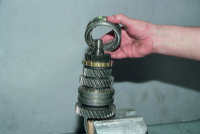
We take out the secondary shaft from the gearbox housing. We install the secondary shaft vertically, clamping it in a vice through cardboard gaskets and remove the synchronizer sleeve for the third and fourth gears
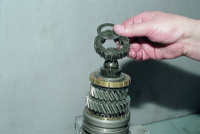
Remove the retaining ring with a puller and remove the synchronizer hub and spring washer
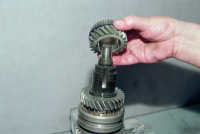
Prying off with a screwdriver, remove the retaining ring, as well as the locking ring and the synchronizer spring. We remove the gear wheel of the third gear
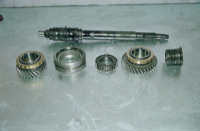
Leaning the gear wheel of the first gear on a hard base, hammer out the secondary shaft with a hammer through a spacer made of soft metal and remove from it the gear wheel of the second gear assembly, the synchronizer clutch of the first and second gears, the hub of the synchronizer, the gear wheel of the first gear assembly and the sleeve of the gear wheel of the first gear
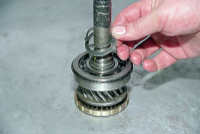
The elements of the synchronizers of the first, second and fourth gears on the input shaft of the gears are disassembled in the same way as the synchronizer for the third gear. To remove the input shaft bearing with a puller, unclench the retaining ring and remove it together with the spring washer
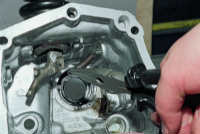
Leaning the bearing on a rigid base, knock out the input shaft with a hammer through a drift from soft metal. To remove the gear lever from the rear cover of the gearbox housing, disconnect the return spring from the lever
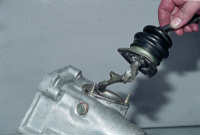
With a 10 key, unscrew the three nuts securing the ball joint of the lever and remove the lever from the studs
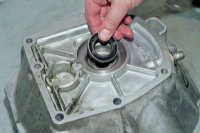
To replace the cuff of the drive input shaft, we knock out the cuff with a punch through the hole in the front cover of the gearbox and remove it. This completes the complete disassembly of the VAZ 2106 gearbox. Assembly and repair of the VAZ 2106 gearbox is performed in the reverse disassembly sequence, taking into account the replacement of worn parts with new ones.
ATTENTION! The gearbox consists of a large number of parts, many of them are similar, therefore, to facilitate assembly, the parts should be laid out on sheets of paper in order and be sure to sign each one.
We drain the oil from the gearbox (see Checking the level and changing the oil in the gearbox).
Remove the gearbox (see Replacing the gearbox).
Remove the clutch release drive plug and the clutch release bearing (see Replacing the pressure plate assembly and the clutch release bearing).
We thoroughly clean it from dirt, wash the gearbox housing with a brush and hot water and detergent from the outside and put it on the workbench with the clutch housing down.
Use two screwdrivers to separate the sectors of the spacer sleeve and.
... remove it and the rubber bushing of the damper.
Remove the elastic coupling and the flange from the secondary shaft of the gearbox (see Replacing the secondary shaft seal).
Using the "13" head, unscrew the two support fastening nuts.
Using the "10" head, unscrew the nut that secures the speedometer drive.
... and remove the speedometer drive.
Using the "22" key, turn off the reverse light switch.
Using the "13" key, turn off the stop for shifting the gear shift lever.
Using the "13" head, unscrew the two nuts securing the bracket.
Remove the bracket and take out the square head bolt.
Using the "13" head, unscrew the remaining nuts securing the rear cover of the gearbox.
Remove the rear cover by moving the shift lever to the right to free it from the gearshift rods.
Carefully, trying not to damage, remove the back cover gasket.
We remove the drive gear of the speedometer drive and its retainer - a steel ball.
Using the "10" head, unscrew the bolt securing the reverse gear shift fork.
Remove the reverse gear fork and reverse intermediate gear.
Remove the remote sleeve from the reverse gear rod.
Remove the retaining ring from the intermediate shaft with a puller.
Remove the reverse drive gear and spring washer.
With a puller, remove the retaining ring from the secondary shaft.
Remove the reverse driven gear and spring washer.
Using an impact screwdriver, unscrew the four screws securing the bearing lock plate and the axis of the intermediate reverse gear.
Remove the locking plate.
We take out the axis of the intermediate reverse gear.
Using the "10" head, unscrew ten nuts securing the bottom cover.
We put the gearbox on its side.
Using the "13" head, unscrew one nut.
... and the head "17" - six nuts securing the clutch housing to the gearbox.
Disconnect the crankcases and remove the gasket.
Using the "13" head, unscrew the two bolts securing the cover of the rod clamps.
Remove the cover and remove three springs and three balls from the holes.
We take out the rod of the reverse switch.
Using the "10" head, unscrew the bolt securing the plug for engaging 1st and 2nd gears.
We take out the rods, at the same time removing the locking crackers.
We take out the rod of the plug of inclusion of the 1st and 2nd gears.
Using the "10" head, unscrew the bolt securing the plug for engaging the III and IV gears.
We take out the rod of the plug for engaging the III and IV gears.
By clicking on the couplings, we turn on two gears at once and with the key "19" unscrew the bolt securing the front bearing of the intermediate shaft.
Prying the retaining ring with two screwdrivers, take out the front intermediate shaft bearing.
We push out the rear bearing of the intermediate shaft.
Tilting, remove the intermediate shaft from the gearbox housing.
We take out two gear shift forks.
Prying off with a screwdriver, take out the input shaft assembly with the bearing and the synchronizer ring.
Remove the needle bearing from the secondary shaft.
Prying with a screwdriver, remove the key from the back of the secondary shaft.
Prying off with two screwdrivers, remove the rear bearing of the output shaft.
We take out the secondary shaft from the gearbox housing.
We install the secondary shaft vertically by clamping it in a vice through cardboard spacers.
Remove the synchronizer sleeve for III and IV gears.
Remove the retaining ring with a puller.
... and remove the synchronizer hub and spring washer.
Prying off with a screwdriver, remove the retaining ring, as well as the locking ring and the synchronizer spring.
We remove the gear wheel of the III transfer.
Leaning the gear wheel of the 1st gear on a hard base, knock out the secondary shaft with a hammer through a spacer made of soft metal.
... and remove from it the 2nd gear gear assembly, the synchronizer clutch for 1st and 2nd gears, the synchronizer hub, the 1st gear gear assembly and the 1st gear gear sleeve.
The elements of the synchronizers I, II and IV (on the input shaft) of the gears are disassembled in the same way as the synchronizer for the III gear.
To remove the input shaft bearing.
... unclench the retaining ring with a puller.
... and remove it together with the spring washer.
Leaning the bearing on a rigid base, knock out the input shaft with a hammer through a drift from soft metal.
To remove the shift lever from the rear transmission housing cover.
... disconnect the return spring from the lever.
Using the "10" wrench, unscrew the three nuts securing the ball joint of the lever and.
To replace the cuff of the drive (primary) shaft, we knock out the cuff with a punch through the hole in the front cover of the gearbox and.
Repairing a VAZ 2106 gearbox will be a job consisting of a large number of parts, many similar, therefore, to assemble the parts, it is recommended to lay out in order and sign each part.
First you need to drain the oil from the gearbox. Then remove the transmission.
Remove the clutch yoke and clutch release bearing. Thoroughly clean from dirt, wash the gearbox housing with a brush with hot water and detergent inside and out. Place the clutch housing down on a workbench.
Using two screwdrivers, part the spacer sleeve sectors.
Remove the damper rubber grommet.
Remove flexible coupling and flange from gearbox shaft.
Using the "13" head, unscrew the 2 support fastening nuts.
Using the “10” head, unscrew the nut of the speedometer drive and remove it.
Unscrew the reverse switch with the "22" key.
Using the "13" wrench, unscrew the gear lever stop.
Using the “13” head, unscrew the 2 nuts securing the bracket.
Remove the bracket and remove the bolt.
Using the "13" head, unscrew the nuts securing the gearbox cover.
Remove the speedometer drive gear and steel ball.
Using the "10" head, unscrew the bolt securing the reverse gear.
Remove the fork and reverse gear.
Remove the ring from the shaft with a puller.
Remove the reverse gear.
Remove the ring from the shaft with a puller.
Remove the reverse gear.
Use an impact screwdriver to unscrew the 4 screws securing the bearing plate.
Remove the reverse gear axle.
Using the "10" head, unscrew 10 nuts securing the cover.
Unscrew the nut with the "13" head
"By 17" unscrew the 6 nuts securing the crankcase to the gearbox.
Using the "13" head, unscrew the 2 bolts of the rod cover.
Remove the cover and remove 3 springs and 3 balls from the holes.
Remove the rod of the reverse fork.
Using the “10” head, unscrew the bolt that secures the 1st and 2nd gear shift fork.
Remove the rods of the forks for 1st and 2nd gears.
Using the “10” head, unscrew the bolt that secures the fork of the 3rd and 4th gears.
Remove the bolt securing the shaft bearing.
Using screwdrivers to pry the retaining ring, remove the front shaft bearing.
Push the shaft bearing outwards.
Remove the shaft from the gearbox housing.
Remove input shaft with bearing.
Remove the needle bearing from the shaft.
Remove the key from the pinion shaft.
Remove the output shaft from the gearbox housing.
Remove clutch for 3rd and 4th gears.
Remove the retaining ring with a puller
Remove the synchroniser ring and spring.
Remove 3rd gear.
We remove from it the 2nd gear gear, the 1st and 2nd gear clutch, gear 1 assembly and the 1st gear sleeve.
Remove circlip with lock washer.
Disconnect the return spring.
Using a "10" wrench, unscrew the 3 nuts of the ball joint of the lever.
Knock out the cuff through the hole in the gearbox cover.
Thoroughly rinse the parts in kerosene and inspect for defects. When repairing a VAZ 2106 gearbox, you need to pay attention to the gear teeth and couplings. Chips, scuffing and wear are not allowed on them. The surfaces of shafts, axles and rods must be perfectly smooth. The crankcase must be free of cracks and the bearings must be free of wear.
Shaft splines should be free of corrosion and galling marks. Damage is repaired with polished sandpaper, but it is better to replace with new parts.
All bearings must be in good condition, their play must not be higher than 0.05 mm, any defects are unacceptable on the tracks. Separators must be free of breaks and touching rings.
If the VAZ 2106 gearbox is being repaired, then it is better to replace all bearings with new ones, regardless of the condition of the old ones. We replace the cuffs in any case. When assembling, it is necessary to lubricate all gearbox elements.
Assemble the gearbox in the reverse order of disassembly. The fork stem spring is stiff and black coated. Before installing the cuffs, cover with a layer of grease. The bolt of the shaft bearing washer is clamped with a torque of 8.1–10.0 kgf.m. The nut of the rear end of the shaft is clamped with a torque of 6.8–8.4 kgf.m.
When there are problems with the gearbox, it must be addressed immediately. If you start this process, you can lose the possibility of repairing the gearbox, and you will need to directly replace it.
DIY VAZ 2106 gearbox repair
Attention. The gearbox consists of a large number of parts, many of them are similar, therefore, to facilitate assembly, the parts should be laid out on sheets of paper in order and be sure to sign each one.
1. Drain the oil from the gearbox.
2. Remove the gearbox.
3. Remove the clutch release drive plug and the clutch release bearing.
4. Thoroughly clean it from dirt, wash the gearbox housing with a brush and hot water and detergent from the outside and place it on the workbench with the clutch housing down.
5. Use two screwdrivers to separate the sectors of the spacer sleeve and ...
6.… remove it and the rubber bushing of the damper.
7. Remove the flexible coupling and flange from the gearbox output shaft.
8. Using the "13" head, unscrew the two support fastening nuts.
10. Using the "10" head, unscrew the nut that secures the speedometer drive ...
11. ... and remove the speedometer drive.
12. Using the "22" key, turn off the reverse light switch ...
14. Using the "13" key, turn off the stop for shifting the gear shift lever.
15. Using the "13" head, unscrew the two nuts securing the bracket.
16. Remove the bracket and take out the square head bolt.
17. Using the "13" head, unscrew the remaining nuts securing the rear cover of the gearbox.
eighteen.Remove the rear cover by moving the shift lever to the right to free it from the gearshift rods.
19. Carefully, trying not to damage, remove the back cover gasket.
20. Remove the rear bearing.
21. Remove the drive gear of the speedometer and its retainer - a steel ball.
22. Remove the reverse gear and reverse intermediate gear.
23. Remove the distance sleeve from the reverse gear rod.
24. With a puller, remove the retaining ring from the intermediate shaft.
25. Remove the reverse drive gear and spring washer.
26. With a puller, remove the retaining ring from the secondary shaft.
27. Remove the driven reverse gear and spring washer.
28. Using an impact screwdriver, unscrew the four screws securing the bearing lock plate and the axis of the intermediate reverse gear.
29. Remove the locking plate.
30. Take out the axis of the intermediate reverse gear.
31. Using the “10” head, unscrew ten nuts securing the bottom cover.
32. Remove the cover. We put the gearbox on its side.
33. Using the "13" head, unscrew one nut, ...
34. ... and the head "17" - six nuts securing the clutch housing to the gearbox.
35. Disconnect the crankcases and remove the gasket.
36. Using the "13" head, unscrew the two bolts securing the cover of the rod retainers.
37. Remove the cover and remove three springs and three balls from the holes.
38. Take out the rod of the reverse engagement fork.
39. Using the "10" head, unscrew the bolt securing the plug for engaging 1st and 2nd gears.
40. We take out the rods, at the same time removing the blocking crackers.
41. We take out the rod of the plug of inclusion of the 1st and 2nd gears.
42. Using the “10” head, unscrew the bolt securing the plug for engaging the III and IV gears.
43. We take out the rod of the plug of inclusion of III and IV gears.
44. By clicking on the couplings, we turn on two gears at once and with the key "19" unscrew the bolt securing the front bearing of the intermediate shaft.
45. Prying the retaining ring with two screwdrivers, take out the front bearing of the intermediate shaft.
46. We push out the rear bearing of the intermediate shaft.
47. Having tilted, take out the intermediate shaft from the gearbox housing.
48. We take out two gear shift forks.
49. Prying with a screwdriver, take out the input shaft assembly with the bearing and the synchronizer ring.
50. Remove the needle bearing from the secondary shaft.
51. Prying with a screwdriver, remove the key from the back of the secondary shaft.
52. Prying off with two screwdrivers, remove the secondary shaft rear bearing.
53. We take out the secondary shaft from the gearbox housing.
54. Vertically install the secondary shaft, clamping it in a vice through cardboard spacers. Remove the synchronizer sleeve for III and IV gears.
55. Remove the retaining ring with a puller ...
56. ... and remove the synchronizer hub and spring washer.
57. Prying off with a screwdriver, remove the retaining ring, as well as the locking ring and the synchronizer spring.
58. We remove the gear wheel of the III transfer.
59. Leaning the gear wheel of the 1st gear on a hard base, knock out the secondary shaft with a hammer through a spacer made of soft metal ...
60. ... and remove from it the II gear assembly, the synchronizer coupling for the 1st and 2nd gears, the synchronizer hub, the 1st gear assembly and the 1st gear sleeve.
61. Elements of synchronizers I, II and IV (on the input shaft) gears are disassembled similarly to the synchronizer of III gear.
62. To remove the input shaft bearing with a puller, unclench the retaining ring ...
63. ... and remove it together with the spring washer.
64. Leaning the bearing on a rigid base, knock out the input shaft with a hammer through a drift from soft metal.
65. To remove the gear shift lever from the rear cover of the gearbox housing, disconnect the return spring from the lever.
66. Using the "10" wrench, unscrew the three nuts securing the ball joint of the lever and ...
67.… remove the lever from the studs.
68. To replace the cuff of the drive (primary) shaft, we knock out the cuff with a punch through the hole in the front cover of the gearbox and ...
We thoroughly wash all parts in kerosene or diesel fuel and inspect them. The teeth of gears and couplings should be free of chips, scoring, fatigue chipping and noticeable wear.The surfaces of shafts, axles and shift rods must be completely smooth, free from scoring, pits and severe wear. There should be no cracks or nicks on the crankcase, and there should be no wear or traces of turning in the bearing bores. Corrosion and traces of crushing and galling are unacceptable on the shaft splines. Minor damage can be repaired with fine sandpaper followed by polishing, but it is better to replace damaged parts with new ones.
All rolling bearings, both ball and roller, must be in perfect condition, their radial play must not exceed 0.05 mm, any defects on the tracks and rolling elements are unacceptable. Separators should not have breaks, touching rings and melting (for plastic ones). In general, if the "mileage" of the box exceeds 120 thousand km and the unit is being repaired with disassembly, it is better to replace all bearings with new ones, regardless of their condition, especially if severe damage to gears and gear clutches was noticed. We replace the cuffs with new ones in any case. When assembling, we lubricate all the parts of the box, incl. the bearing seats and the bearings themselves with transmission oil, the joints of the crankcase and covers are covered with a thin layer of oil-resistant sealant, and the parts of the switching mechanism are coated with SHRUS-4 grease.
| Video (click to play). |
We assemble the gearbox in the reverse order of disassembly. The spring of the reversing fork rod retainer is different from others in stiffness and has a black coating. Before installation, the working surface of the cuffs is coated with a thin layer of Litol-24 grease. We tighten the bolt of the intermediate shaft bearing clamping washer with a torque of 8.1–10.0 kgf.m. We tighten the nut of the rear end of the secondary shaft with a torque of 6.8–8.4 kgf.m.

